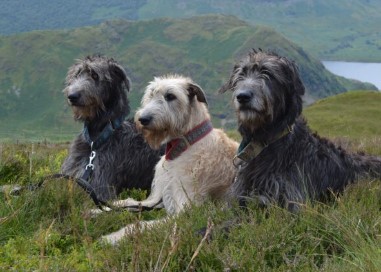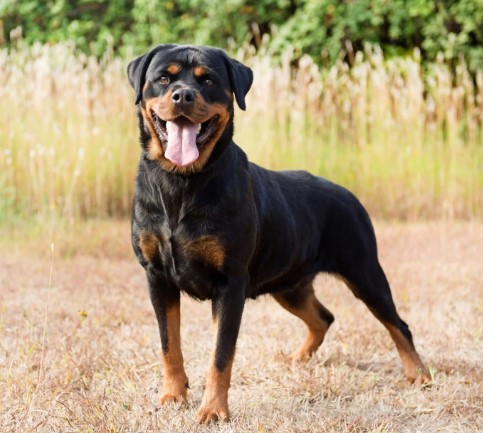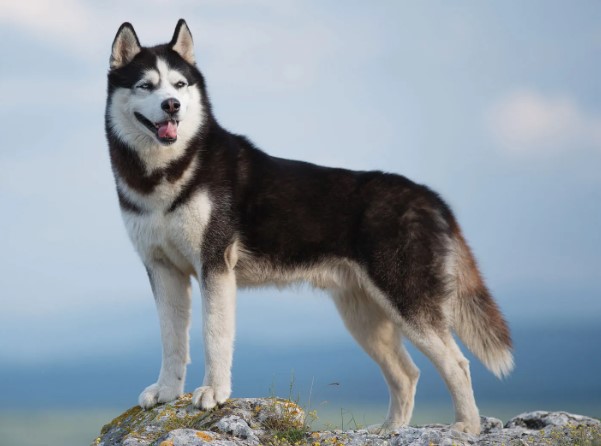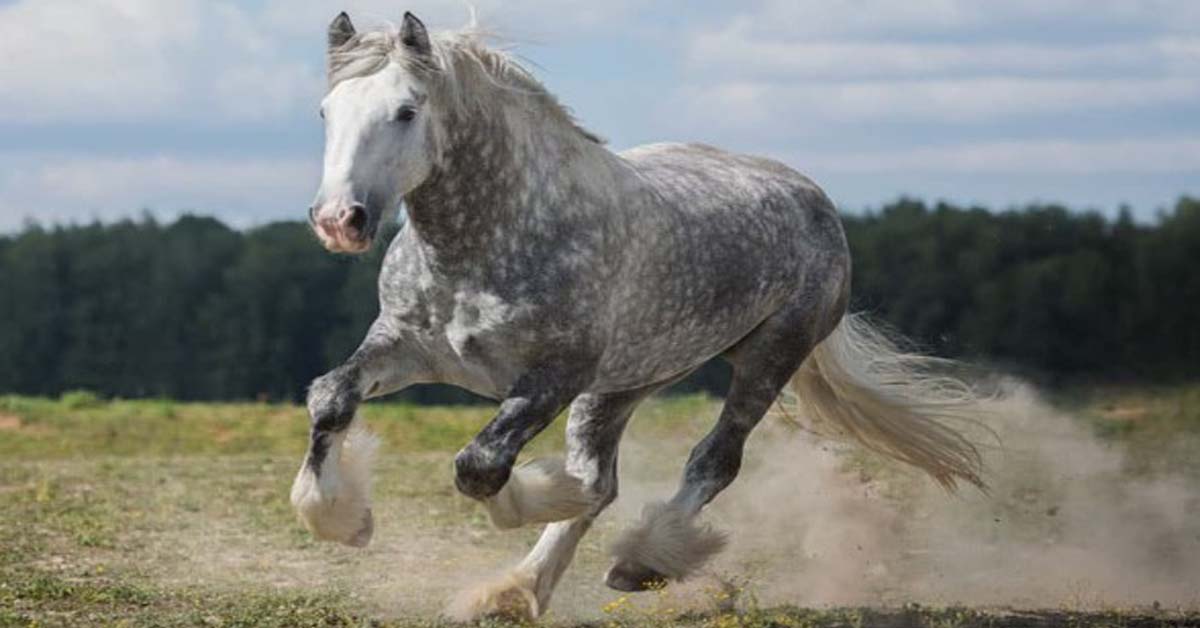The Irish wolfhound, the tallest dog breed, hails from Ireland and can reach up to 7 feet tall when standing on their hind legs. They possess a medium-length, wiry double coat, and a lean yet strong physique.
Despite their imposing size, these dogs are gentle giants, known for their calm nature. With adequate space, they can make excellent companions. Initially bred for hunting large game, they are now predominantly cherished as family pets.
origin of Irish Wolfhound Dog

The Irish wolfhound, the tallest dog breed, hails from Ireland and can reach up to 7 feet tall when standing on their hind legs. They possess a medium-length, wiry double coat, and a lean yet strong physique.
Despite their imposing size, these dogs are gentle giants, known for their calm nature. With adequate space, they can make excellent companions. Initially bred for hunting large game, they are now predominantly cherished as family pets.
size of Irish Wolfhound Dog
For males, The Irish wolfhound typically stands between 30 and 32 inches tall, while females usually range from 28 to 30 inches in height.
weight of Irish Wolfhound Dog
Male Irish wolfhounds typically weigh between 140 and 180 pounds, while females generally weigh between 115 and 140 pounds.
Irish Wolfhound lifespan
The average lifespan of an Irish Wolfhound is 6 to 8 years.
Breed characters of Irish Wolfhound Dog

Irish Wolfhounds are known for their friendly temperament, despite their size. They are usually very affectionate with their families and generally have an easygoing, quiet personality.
With adequate training and socialization, they can be good around children. Although they have a moderate energy level, they require ample space for exercising their large bodies.
Irish Wolfhound puppies take a long time to mature, so you may have a large puppy that doesn’t always behave according to its size. This trait can be frustrating for owners who prefer adult behavior and a dog that isn’t always rambunctious.
History of Irish Wolfhound Dog

The History of the Irish wolfhound dates back centuries to the establishment of trade between the British Empire and the Middle East. Native British dogs were crossbred with Middle Eastern hounds acquired through trade.
One of the earliest documented mentions of the breed comes from a Roman consul in 391 AD, who described seven impressive Irish hounds gifted to him.
These large hounds were primarily used for hunting big game. By the 15th century, they were employed to tackle the problem of wolf overpopulation in Ireland. Their effectiveness in hunting led to the extinction of wolves in Ireland—and almost to the demise of the wolfhound breed itself, as their purpose had been fulfilled.
However, in the mid-1800s, a British army captain rediscovered the remaining Irish wolfhounds and embarked on a mission to preserve and standardize the breed. The American Kennel Club officially recognized the Irish wolfhound in 1897.
Appearance of Irish Wolfhound Dog

Irish Wolfhounds are remarkably large dogs, standing at a height of up to 88cm, which is taller than some Shetland ponies! Their coat comes in various colors, such as grey, black, red, and fawn, though many are a similar shade of grey or black, resembling a wolf.
They are characterized by a bushy beard and eyebrows, giving them a distinctive and expressive appearance.
Temperament of Irish Wolfhound Dog

The temperament of the Irish Wolfhound is often described by the phrase “gentle when stroked, fierce when provoked.”
Overall, they are placid and tolerant dogs. However, they can be protective of their home and owners, making them good guard dogs if needed.
Personality of Irish Wolfhound Dog

The Irish Wolfhound is known as the gentle giant of the dog world, characterized by its friendly and kind nature. However, puppies and young adults can be energetic and boisterous, which may not be ideal for families with young children.
They generally get along well with other dogs, although some may be intimidated by their size. Due to their eventual enormous size, they may not be suitable for many families. However, for those who can accommodate their needs, they prove to be devoted companions.
Health of Irish Wolfhound Dog

If you’re considering purchasing a puppy or breeding from your dog, it’s crucial to be aware of the potential health issues in your breed.
To address these concerns, we recommend that breeders utilize DNA tests, screening schemes, and inbreeding coefficient calculators. These tools can help breed the healthiest dogs possible.
care of Irish Wolfhound Dog

The Irish Wolfhound, despite being a gentle giant, requires significant time and energy from you. It’s essential to ensure your dog has daily opportunities to stretch their legs.
Consistency in training and socialization is also key. Fortunately, grooming needs for the Irish Wolfhound are relatively simple, even given their size.
Exercise Plan to dedicate at least an hour each day to exercising your Wolfhound. Many are excellent jogging or running partners (once fully developed), and they enjoy long walks and hikes. Participation in dog sports like tracking and agility can also provide mental and physical stimulation.
Given their size, ample space is necessary. Ideally, your Wolfhound should have access to a fenced yard where they can run freely and stretch their legs. Always remember their sighthound nature, as their prey drive can be triggered unexpectedly. Therefore, it’s best to let them run only in enclosed spaces.
When adequately exercised, Irish Wolfhounds are typically calm indoors. Some owners find they need to encourage their dogs to exercise, as they can be quite content lounging around. While they can adapt to apartment living, it’s crucial to provide sufficient outdoor space for them to expend their energy and exercise.
feeding of Irish Wolfhound Dog

Feeding an Irish Wolfhound requires careful attention to their nutritional needs. Here are some feeding guidelines:
- Opt for high-quality dog food designed for large breeds.
- Follow the manufacturer’s recommended portion sizes, adjusting as necessary based on your dog’s age, activity level, and health status.
- Split their daily food intake into two or three meals to prevent bloating and aid digestion.
- Minimize treats and table scraps to avoid weight gain and other health issues.
- Ensure fresh water is always available throughout the day.
- Consult with a veterinarian if you have any concerns about your Irish Wolfhound’s diet or weight, as they can provide personalized recommendations.
RELATED POSTS:
The Top 20 Biggest Dogs in the World: 2024 Edition
Saarloos Wolfdog
Berger Picard Dog
Grooming of Irish Wolfhound Dog

Proper grooming is essential for ensuring your Irish Wolfhound reaches its maximum life expectancy. This goes beyond just medical care; it also involves keeping the dog clean and tidy to prevent mats, excess fur, and skin or foot issues.
Irish Wolfhounds have a double coat consisting of a coarse, wiry outer layer and a soft undercoat. While they do shed, it is not excessive. Regular brushing once a week helps maintain a neat appearance and removes dirt.
Unlike some other double-coated breeds, Irish Wolfhounds do not undergo a heavy shedding season. As with all breeds, keeping their nails trimmed is crucial, as long nails can be uncomfortable and hinder their ability to walk and run.
Dental care is highly important for dogs, as it can impact their overall health. Regular brushing is recommended to prevent tartar and plaque buildup, which can lead to tooth decay and gum disease. If your Wolfhound develops dental issues, prompt veterinary attention is crucial for effective treatment.
Training of Irish Wolfhound Dog

The Irish Wolfhounds generally respond well to training due to their attentive nature. However, it’s crucial not to become complacent in your efforts, as this can result in a large and dominant dog. Consistent and clear obedience training should start early in puppyhood, coupled with thorough socialization, to develop a well-rounded and amiable companion.
Expose your dog to various people and situations from a young age to build comfort and confidence. Leash training is particularly important for this large breed, especially if you anticipate children walking them.
Positive training methods are essential for Irish Wolfhounds, as harsh corrections or negative experiences can cause these sensitive dogs to become disengaged and less receptive to learning.
Exersize of Irish Wolfhound Dog

Your Irish Wolfhound will need at least 2 hours of walking or hiking per day and typically isn’t well-suited for off-lead exercise.
A spacious outdoor area is essential for raising an Irish Wolfhound, especially when long walks aren’t feasible, such as during heatwaves.
FAQ of Irish Wolfhound Dog

What is an Irish Wolfhound used for?
The Irish Wolfhound was highly valued for its hunting abilities, especially in chasing down wolves and the massive Irish elk. However, as these animals disappeared from Ireland and many Wolfhounds were exported, the breed nearly faced extinction
Why not to get an Irish Wolfhound?
“Day 16: Gentle Giants: The Pros and Cons of Having an Irish Wolfhound
Health Issues: Similar to many large breeds, Irish Wolfhounds are susceptible to specific health problems, including hip dysplasia, bloat, and heart disease. Treating these conditions can be costly and demanding in terms of care and attention.
Space Requirements: Irish Wolfhounds are not suitable for small apartments or homes with limited space.”
Do Wolfhounds eat a lot?
An Irish Wolfhound, weighing around 190lbs, consumes approximately 7 cups of food daily, which can be quite expensive to sustain such a large dog! For a purebred Wolfhound weighing around 130lbs, you’d likely need to provide around 5–6.5 cups of food daily
What do Irish Wolfhounds like to eat?
The Irish Wolfhound Feeding Guide advocates for a raw food diet that mimics what dogs would consume in the wild. This diet includes meat, bone, offal, and a small portion of plant ingredients, all of which provide essential vitamins and minerals for a healthy meal.
Do wolfhounds feel the cold?
Irish Wolfhounds are typically well-equipped for cold weather and can tolerate low temperatures better than many other breeds. Their dense, wiry coat acts as insulation and offers protection from the elements, aiding in keeping them warm in chilly conditions.











